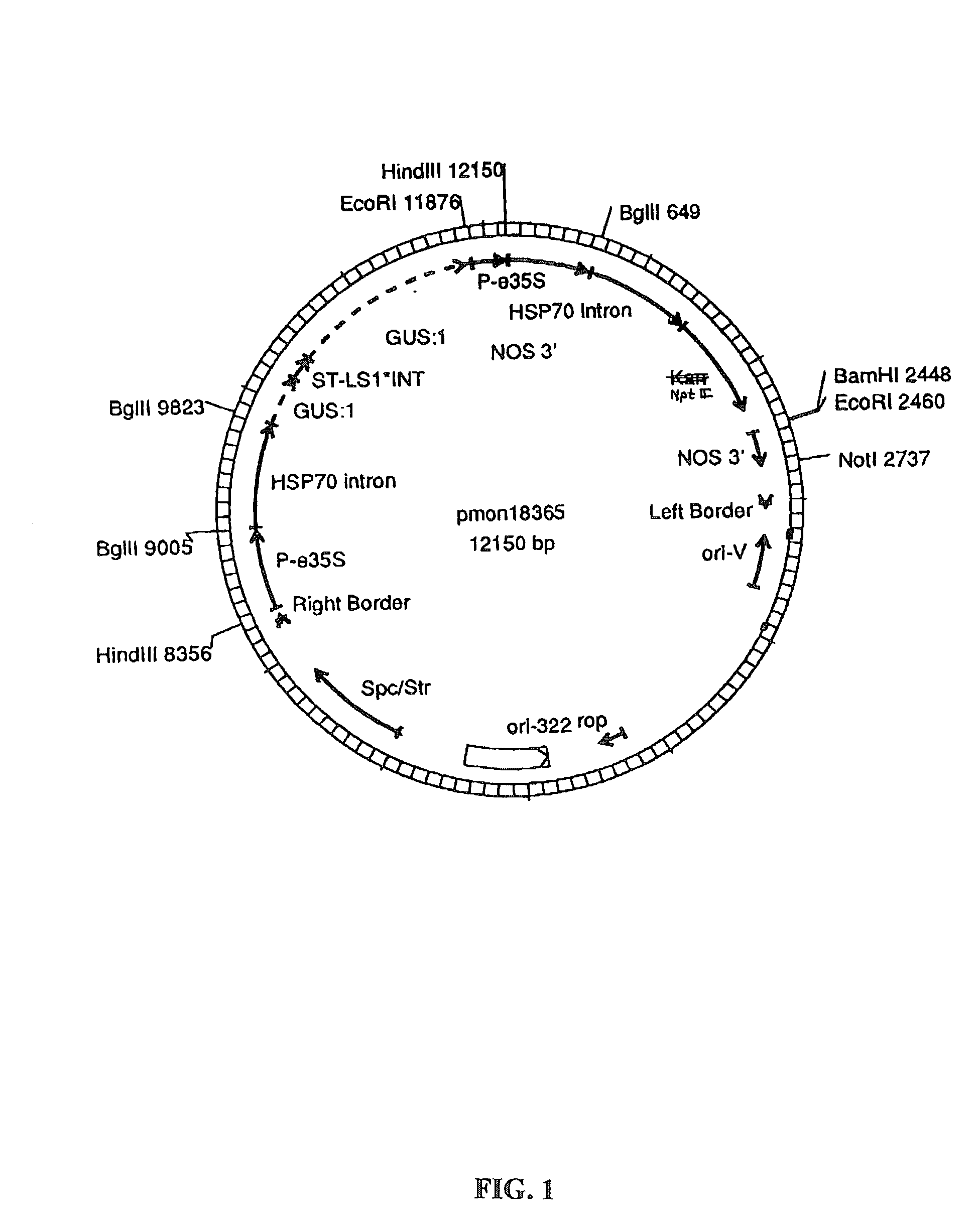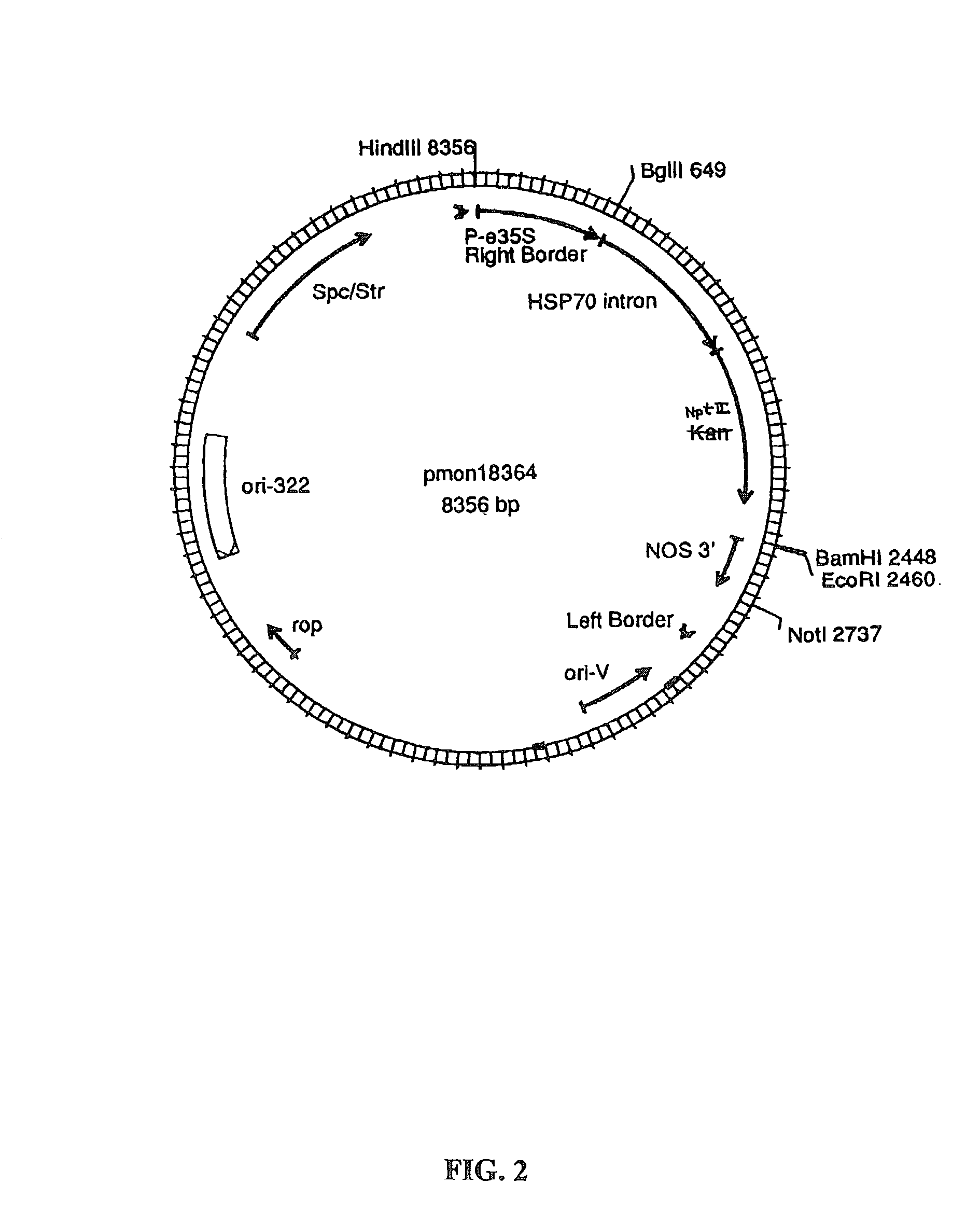Methods for the production of stably-transformed, fertile wheat employing agrobacterium-mediated transformation and compositions derived therefrom
a technology of agrobacterium and agrobacterium, applied in the field of molecular biology, can solve the problems of lack of prior art, no convincing reports exist on the use of agrobacterium in the preparation of stable, fertile, wheat transgenic plants, etc., and achieve high gus gene expression, stable transformation efficiency, and high transformation efficiency.
- Summary
- Abstract
- Description
- Claims
- Application Information
AI Technical Summary
Benefits of technology
Problems solved by technology
Method used
Image
Examples
example 1
5.1 Example 1
Transformation Using Immature Embryos
5.1.1 Explant Preparation
[0097]A spring wheat Triticum aestivum cv. Bobwhite was used throughout this study. Stock plants were grown in an environmentally controlled growth chamber with 16-h photoperiod at 800 μmol m−2s−1 provided by high-intensity discharge (HID) Sylvania lights (GTE Products Corp., Manchester, N.H.). The day / night temperatures were 18 / 16° C. Immature caryopses were collected from the plants 14-d after anthesis. Immature embryos (IEs) were dissected aseptically and cultured on one of the following pre-culture media before inoculation: 1) semisolid callus induction medium CM4 or CM4C (TABLE 5) for 1–6 d; 2) liquid CM4C supplemented with 0.25 M raffinose and mannitol, respectively, for 1 d; 3) liquid CM4 medium with 1 / 10 strength of the MS salts and supplemented with 10 g / l glucose, 3.9 g / l MES for 1 to 3 h. All the cultures were conducted at the temperature of 23–25° C.
[0098]
TABLE 5Supplemental Components Basic Media...
example 2
5.2 Example 2
Transformation Using Embryogenic Callus
5.2.1 Explant Preparation
[0113]Immature embryos of wheat (Triticum aestivum L.) cv Bobwhite were isolated from the immature caryopsis 14 days after anthesis and cultured on callus induction medium CM4 or CM4C (TABLE 9) with scutellum-side up. After 10 days or longer, immature embryos developed into embryogenic callus. Each callus piece was approximately 5 mm or bigger. The callus pieces were inoculated with Agrobacterium without being broken down (intact), or only the most embryogenic callus sections were selected and broken down into small pieces (˜2 mm) using fine-pointed forceps for inoculation.
5.2.2 Inoculation and Co-Cultivation
[0114]Callus pieces were inoculated with the Agrobacterium cell suspension prepared as described above, using one of the following methods:
[0115]1) Immersing the callus pieces in the Agrobacterium cell suspension for 3 h.
[0116]2) Immersing the callus pieces in the Agrobacterium cell suspension with vacu...
example 3
5.3 Example 3
Transformation of Suspension Cells
5.3.1 Explant Preparation
[0123]Wheat v. Mustang suspension cells were cultured in liquid MS1WSM (TABLE 9) at 28° C. in the dark on a rotary shaker (250 rpm). Cells harvested after 3 d subculture were used for inoculation with Agrobacterium. The general protocol for transformation of suspension cells is given in FIG. 7.
[0124]5.3.2 Agrobacterium Culture and T-DNA Delivery The Agrobacterium culture method was essentially the same as described in Example 1. The Agrobacterium cell density was adjusted to OD660 0.5–1 in inoculation medium (CM4 medium with 1 / 10 strength of the MS salts and 3.9 g / l MES and supplemented with 10 g / l glucose and 200 μM acetosyringone. Liquid medium was removed from the wheat suspension culture by vacuum. Each ml of the wheat cells was mixed with 3 ml of the Agrobacterium cell suspension petri dishes (100×25 mm). The inoculation was performed at 23–25° C. for 30 min to 4 h. After inoculation, Agrobacterium-infected...
PUM
| Property | Measurement | Unit |
|---|---|---|
| temperature | aaaaa | aaaaa |
| cell density | aaaaa | aaaaa |
| cell density | aaaaa | aaaaa |
Abstract
Description
Claims
Application Information
 Login to View More
Login to View More - R&D
- Intellectual Property
- Life Sciences
- Materials
- Tech Scout
- Unparalleled Data Quality
- Higher Quality Content
- 60% Fewer Hallucinations
Browse by: Latest US Patents, China's latest patents, Technical Efficacy Thesaurus, Application Domain, Technology Topic, Popular Technical Reports.
© 2025 PatSnap. All rights reserved.Legal|Privacy policy|Modern Slavery Act Transparency Statement|Sitemap|About US| Contact US: help@patsnap.com



